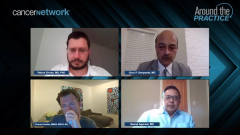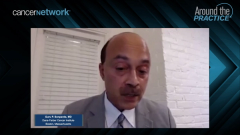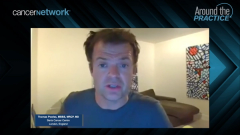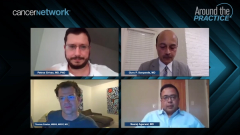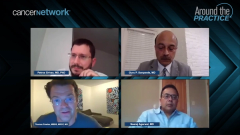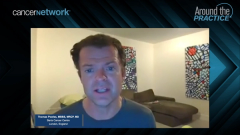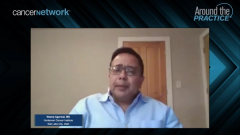
Using Avelumab Maintenance in Advanced Urothelial Cancer
Experts in bladder cancer discuss when it’s appropriate to use avelumab maintenance therapy both with and without progression of disease in advanced urothelial cancer.
Episodes in this series

Petros Grivas, MD, PhD: Let’s move to the next case. You have a patient who has been using avelumab maintenance for a while, and this patient has continued to stable disease on 3 consecutive scans. The question is: “Would you consider avelumab maintenance long term if the patient has stable disease with no progression, or will you change to a different paradigm?” I’d like the audience to vote. Do you continue this patient with stable disease, or do you switch? No progression. Neeraj, how often do you image these patients? Do you continue progression of toxicity based on the JAVELIN Bladder 100 trial?
Neeraj Agarwal, MD: Yes, progression of toxicity. The vast majority of these patients will have disease progression in 1 to 2 years. Once we get to the realm of somebody responding to maintenance avelumab for more than 2 years—it hasn’t occurred in my practice for more than 1 year—I bring up the question of how long we’re going to continue immunotherapy. Obviously, we’d love to have these patients more often in my clinic. When these patients, long-term responders, appear in my clinic, I bring up the discussion of how long. I tend to offer discontinuation of immune checkpoint inhibitors after 2 years of ongoing response if patients have received CR [complete response] or PR [partial response]. For stable disease, it’s much more difficult to convince myself and my patient to stop immune checkpoint inhibitors. That’s my thinking.
Petros Grivas, MD, PhD: Thank you, Neeraj. It’s a good question. There’s a trial in the Alliance group with Dr [Xiao] Wei from Dana-Farber [Cancer Institute], a colleague of Dr Sonpavde, who’s leading the trial that’s looking at the optimal duration of immunotherapy and that has a different duration. Different trials for JAVELIN Bladder 100—as you mentioned, the continuation of progression or unacceptable toxicity. The audience responded to the poll stating that if this patient had stable disease, they’d continue avelumab in that case because there was no progression.
Speaking about progression, let me ask Guru, if this patient has progression avelumab at some point in the future, what would you do with that patient and how would you treat them?
Guru P. Sonpavde, MD: At that point there are some options. We have avelumab approved in the third-line setting after platinum and PD1 inhibition. I guess we’ll talk about that more. There’s erdafitinib, the FGFR inhibitor approved in the post-platinum patients with FGFR3 or FGFR2 activating mutations for fusions. Both are options. There’s 1 more drug: atezolizumab…, which is an antibody-drug conjugate that targets drop 2, as opposed to enfortumab, which targets NK4. Thus, we have multiple options to think about, and we can base that on patient preferences and comorbidities.
Petros Grivas, MD, PhD: Thank you, Guru. We have a couple of questions before we close. But I want to ask Tom about the EV [enfortumab vedotin] trial that he and others led and that was published in the New England Journal of Medicine. We had this discussion during the Uromigos podcast that Tom and Brian led. Tom, any comments on how to treat these patients after progression of avelumab?
Thomas Powles, MBBS, MRCP, MD: It’s relatively straightforward. I wish it was more complicated. At the moment, we don’t have that many terrific options for patients whose cancer progressed after platinum-based chemotherapy followed by maintenance of avelumab. Enfortumab vedotin is a very active drug with a response rate of 40% in this setting. My experience is that it’s good at getting rapid control of disease, which you need in platinum- and avelumab-refractory disease. As I said, those cancers grow fast. If you lose control, you lose control fast. I prefer enfortumab vedotin over other options because it’s the only trial that has level 1A evidence with an overall survival advantage.
I’m excited about the THOR trial looking at erdafitinib. I’m also excited about the sacituzumab govitecan trials that are randomized in the future as well. But at the moment that does seem to stand out for me. The EV [enfortumab vedotin] response rate from the back of the room looks higher than we see for sacituzumab—not much higher, but it looks a little higher. In the toxicity profile, the 2 drugs are distinct. There’s a particular education and training program required around antibody-drug conjugate adverse-event profiles. They’re not straightforward. Both have challenges associated with that. But it’s a very new and exciting area. Perhaps the most exciting thing about it is that if we combine these drugs with immune checkpoint inhibitors, we don’t get some of that antagonism that we see among gemcitabine-cisplatin, gemcitabine-carboplatin, and immune checkpoint inhibitors, as in the KEYNOTE-361 and IMvigor130 trials.
Petros Grivas, MD, PhD: Thank you, Tom. Great points.
Transcript edited for clarity.
Newsletter
Stay up to date on recent advances in the multidisciplinary approach to cancer.




